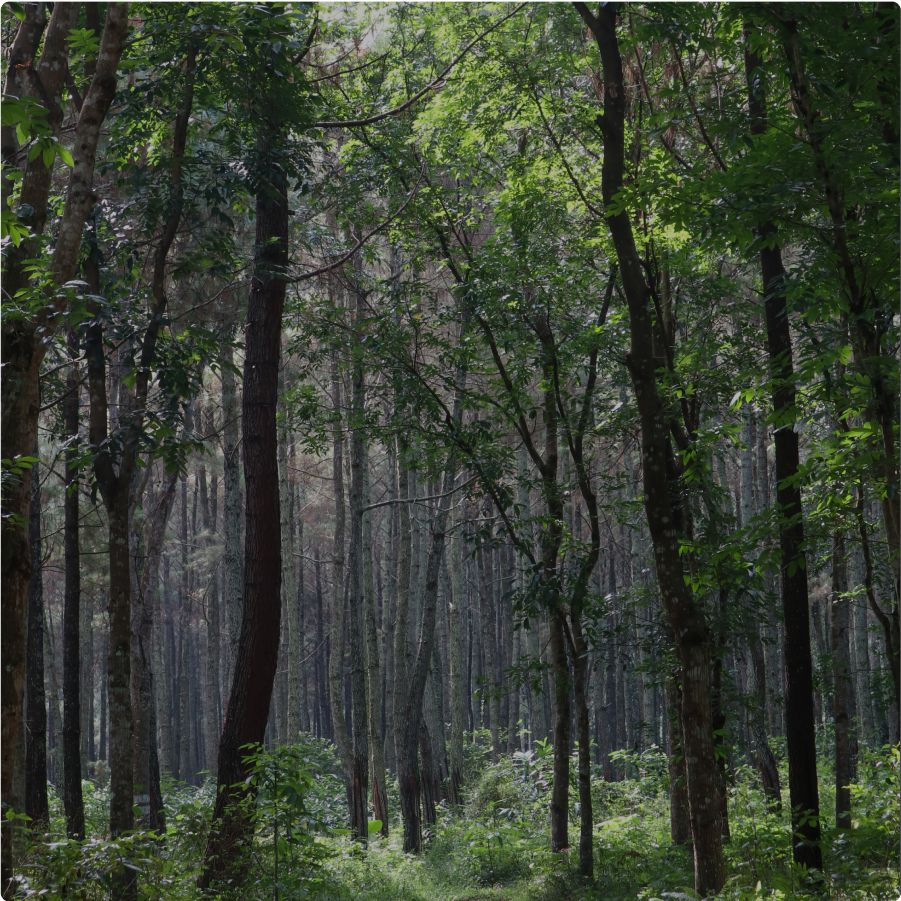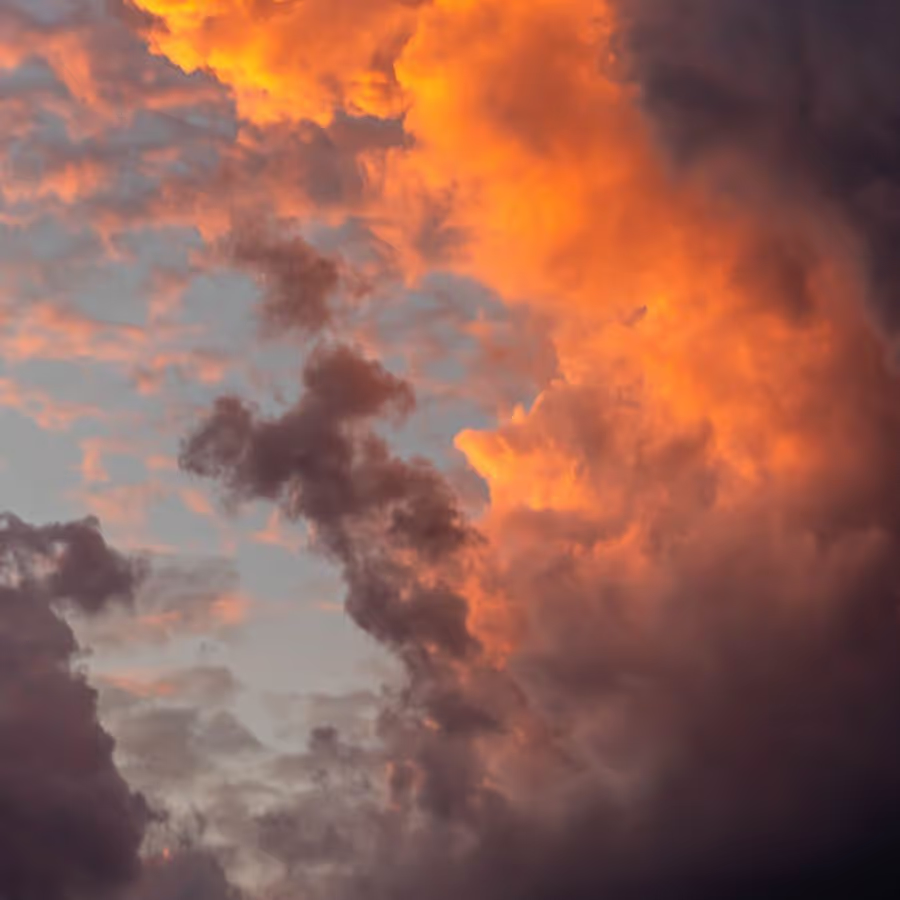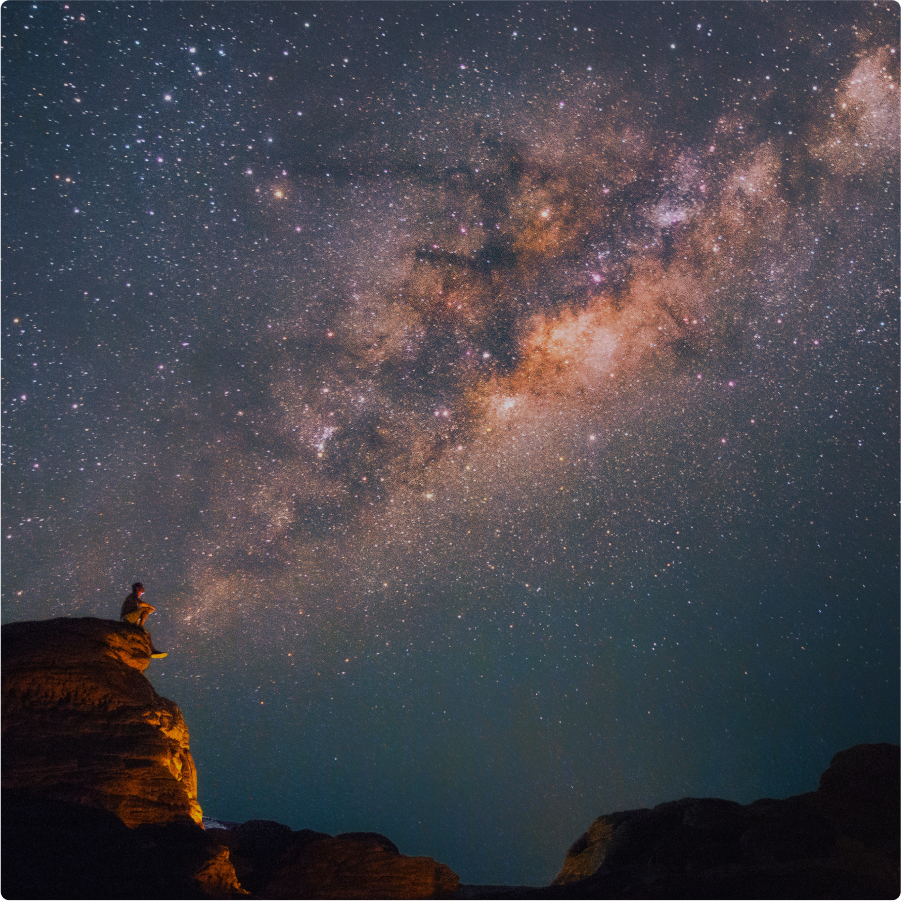Mind Journeys™ for Kids
Let's set our imaginations free on these journeys to far-away places.
Filter by IntentionAn Oceanside Hike to Oregon’s Haystack Rock
We'll travel to the natural wonder that is Haystack Rock in Oregon—a huge rock that sits on the beach surrounded by sand and the Pacific Ocean.
An Oceanside Hike to Oregon’s Haystack Rock
Imagine standing on a steep cliff, overlooking the Pacific Ocean in Oregon. The beach below you is wide and sandy. The horizon is dotted with towering rocks, like sharp cliffs jutting up on the beach. One of these rocks is giant—much bigger than the others; it looks as tall as a city skyscraper.
This is Haystack Rock, our destination for today.
First, find a comfortable place to sit or lie down.
Now, close your eyes, let your shoulders relax, and clear your mind.
Let’s begin by walking slowly toward the wooden staircase that leads down to the beach. It’s a sunny day with fluffy clouds sometimes breaking up the bright sunshine. There is a slight breeze tickling your face and the smell of salty air in your nose.
Stopping at the top of the staircase, look around at the dramatic and rugged coastline.
Look to the left and you’ll see a one-mile-wide expanse of sand with the mountains rising straight up from the beach. This mountain range stretches far into the distance, with many peaks that seem to get smaller the farther you gaze.
Now, look to the right and notice all the colors that paint this landscape: the green and gray in the mountains that stretch in this direction too. There is also a harmony of other colors—the deep blue of the Pacific Ocean, the dark green of forests filled with pine trees, and the golden sand of the beach. And, of course, the browns, greens, greys, and dark blues present on the surface of the massive Haystack Rock.
Grab the handrail of the wooden staircase and walk down toward the sandy beach. With each step, you get a closer look at the wild grasses growing on the dunes. Some of them brush your legs as you climb down the stairs.
With each step, you can feel more of the salty, sticky sea breeze coming off the Pacific Ocean. You can also smell the sweet fragrance of lavender rushing through the air.
Finally, you reach the sand. Take your shoes off and feel your feet touch the cool sand. Your feet sink into its small grains, which fill the spaces between your toes. Wiggle your toes for a moment as you look left, then right—seeing the same landscape from the ground now. The mountains loom overhead—surrounding you and protecting you.
The water on this beach is typically cool, and the air is often chilly and windy. While it’s warm today, you feel a hint of coolness in the breeze skimming off the top of the water.
The tide is low right now, so the beach is as very wide. As you see Haystack Rock ahead, take a minute to imagine how this view would change at high tide with the waves crashing up against it.
Continue walking toward Haystack Rock and notice how vast and beautiful the Pacific Ocean is.
Now, walk closer to where the waves meet the sand. This wetter sand is smooth, but notice how your feet sink a little deeper with each step.
As you walk along the water’s edge, the sound of the waves is slightly louder. You can hear the soft lapping as it gently rolls in and out.
Can you see anything on the sand’s surface as you walk?
There’s a Pacific sand crab just ahead! Take a close look because it is hard to see. The crab has a very small, oval-shaped body, about half the size of your thumb. It’s pale gray and has two small claws and multiple legs that it’s using to burrow in the sand.
As soon as it saw you, the crab quickly clawed its way back underneath the sand. Goodbye, sand crab!
As you get closer to Haystack Rock, find a comfortable spot to sit on the sand and look closely at this natural wonder. How do you feel sitting in its massive presence?
At 235 feet tall, Haystack Rock is a giant and more than 15 million years old! It was made by lava flows from nearby volcanoes.
Imagine if this rock were in an urban area like New York City; it would be almost as tall as the Statue of Liberty, which is 305 feet high! If it were in Washington, D.C., it would be about half the height of the Washington Monument, which is 555 feet high. How does it measure up to the Space Needle in Seattle, which is 605 feet high? Haystack Rock would be about one-third of its height.
Think for a moment about what Haystack Rock would look like next to the tallest building you know.
Now, look at the rock’s texture. It is rough and irregular. What would it feel like to glide your hand across its surface?
If you did, you would be tracing history—from the volcanoes to the lava to the many visible cracks of age and weathering on Haystack Rock. You could trace that history all the way to this very moment, as you notice the numerous barnacles, mussels, and other types of sea life clinging to the rock and using it as their home. How many creatures can you count?
Think about the forces of nature that created Haystack Rock. Think about the length of time it took to mold it into the shape in front of you right now.
Take another few minutes to sit and watch the ocean waves roll in and out, with Haystack Rock in front of you. Ground yourself in this moment in time. Inhale the fresh sea air and feel the cool breeze and warm sun.
It’s time to prepare to end your time with Haystack Rock. Take a few deep breaths while becoming more aware of your surroundings.
If your eyes are closed, open them. Roll your shoulders forward in a big circle three times, stop; then backward three times. Once more, take a deep breath in and slowly exhale.
As you slowly open your eyes and become aware of your surroundings, hold onto the sights and sounds you just experienced at this massive natural wonder that is Haystack Rock.
Visit the Redwood Trees on the James Irvine Trail
Let's walk the James Irvine Trail in Prairie Creek Redwoods State Park and visit some incredible old-growth redwood trees.
A Redwood Forest Hike on James Irvine Trail
Welcome to the James Irvine Trail, a scenic hiking trail in Prairie Creek Redwoods State Park in Northern California.
You are standing at the entrance of the hiking trail and already you can see a forest filled with tall trees shooting upward into the sky. These 2,000-year-old California redwood trees tower over your head, some rising over 350 feet tall. Today, we will walk along a path that begins with enormous redwoods and bushy spruce trees and ends near the coast in Fern Canyon, a dreamlike canyon full of ferns, moss, and waterfalls.
Now, let’s begin your mind journey through this ancient forest.
Find a comfortable place to sit or lie down.
Close your eyes or keep them open, whatever feels most comfortable, and take a few big breaths. Inhale deeply through your nose and exhale slowly through your mouth.
Take three more deep breaths and with each exhale, imagine your feet are more firmly planted on this forest trail.
Now, bring your mind to this trail in front of you, surrounded by ancient, huge redwoods, covered in a canopy of bright green needles against the brilliant blue sky. The sun filters through the trees and the trail is blanketed in soft light.
Start to walk along the trail, enveloped by the sights, sounds, and smells of the forest waking up. Take a moment to imagine the earthy scent of leaves and dirt. Along with this natural scent, a familiar bird call fills the air.
It’s an American robin, with its clear, flute-like notes that rise and fall in pitch, creating a distinctive melody and rhythm. It’s a joyous sound; uplifting and sweet. Let the bird’s song fill your heart and keep you moving forward.
Your steady footfalls add rhythm to the music as you tread on fallen leaves, moss, and branches. Crunch, thump, snap!
Butterflies flutter about, and one lands on a tree trunk right in front of you. Walk up close and take a look, but move slowly so it doesn’t fly away! The butterfly has a wingspan almost the length of your pointer finger. The wings are black and yellow, with eye-catching blue spots on the bottom. You move suddenly, and the butterfly twirls in front of your eyes for a moment before fluttering up into the trees.
Follow the butterfly with your eyes and look up. Notice that the redwood trees are so tall they seem to disappear into the sky. The branches, green and heavy, stretch out in all directions. What are you feeling right now, gazing up at these giants?
See if you can wrap your arms around the rough-barked trunk of one of these trees. You stretch your arms as far as you can but you cannot even reach your arms halfway around it! How does this make you feel? Perhaps this gives you a sense of being very small. Imagine what it must be like to be a tiny bug in our big human world!
Take this moment to remember that you, too, are a part of nature.
Now, still hugging the tree, imagine its roots underground. Dark brown and knobby, the shallow, spreading roots stretch out 100 feet in all directions and intertwine with the roots of other redwoods. Imagine you have roots growing out of your feet, tangling with the redwood roots and linking you to this vast network of trees.
Continue walking along the trail. A couple of red squirrels are scampering among the trees, chirping and chattering as they go about their day. You reach a wooden bridge that crosses a small stream. Skip across it, if you’d like.
A bird flits by you, calling “shook-shook-shook-shook” loudly. This colorful and curious bird is a Steller’s Jay. It lands on a branch, so you can see its black head and dark blue feathers.
What do you think the birds and squirrels have seen today from high in the sky?
As you walk along, the sunlight shines through the trees, casting spotted shadows on the forest floor. It highlights the many different types of green in this forest: the olive-colored moss; the bright green ferns; and the almost-yellow of springtime flowers.
The forest trail climbs higher and crosses a larger stream. Your breathing is easy, steady, and calm, even as you climb up the trail. You hear the unmistakable sound of a black and white Downy Woodpecker. Its drumming sound is so energizing!
Hooray! You have now reached the top of the trail. The Red-Tailed Hawk is screeching in celebration; it gives a piercing whistle as it circles overhead. The large bird of prey has a rusty-red tail, broad wings, and a white underbelly with dark streaks. Watching it soar, you feel light and free.
You continue walking the trail, climbing down now. It lowers gradually, with some small dips and rises along the way. The forest is changing, becoming thick and dense as you move closer to the coast. Brilliant wildflowers are all around: white trilliums, purple violets, and blue lupines.
The trail starts to level out. A family of pale, brown elk is grazing near the trail. Their dark brown heads are bent low to munch and chew. They notice you and lift their heads to look your way. Then they turn around, their white rumps and stubby tails now facing you, to walk away and find a different place to feed.
Near the end of the trail, you reach the enchanting Fern Canyon—a narrow canyon with tall, steep walls covered with lush, dark green drooping ferns; soft, carpet-like moss; and lots of mini-waterfalls. It’s absolutely magical!
Can you count how many shades of green there are?
The wet ground is covered in a soft, spongy layer of fallen leaves and evergreen needles. You can hear water echoing off the canyon walls. A small stream winds its way through the middle of the canyon. A breeze blows through, rustling the ferns, and it sounds as if they are whispering to you. What do you imagine they say?
The trail ends here, as does this mind journey. Take a moment to hold onto the spectacular sights, sounds, and smells. Think about the birds, plants, and animals you’ve encountered on this trail. Did you feel connected to all of them?
Take three long, slow, deep breaths.
Gradually work your way back to your present moment. If your eyes are closed, open them now.
As you go about your day, hold onto the sense of wonder you experienced on the James Irvine Trail.
Listen to a Rainstorm in a Tropical Jungle
We'll take you to a lush, tropical jungle, with rolling hills, river valleys, and several volcanoes.
A Tropical Jungle Rainstorm
Welcome to a lush, tropical jungle, with rolling hills, river valleys, and several volcanoes. It’s bursting with natural beauty—colorful plants and exotic creatures galore! The air is thick with moisture and always warm.
You can feel little beads of moisture on your forehead and arms.
Jungles have a dry season and a rainy season. During the dry season, the days are mostly rain-free and full of sunshine.
During the rainy season, rain showers pour through the canopy, sometimes delicately—like thousands of tiny, cool kisses on your head. And still other times, rains come down with force and might and warm gusts of wind. It’s quite an experience!
And fortunately, you are here to experience the rainy season in this tropical jungle.
First, find a comfortable seated or lying position. Now, think about the word that best describes how you usually feel about rain.
Feel free to say that word aloud.
Close your eyes, or leave them open if you prefer. Take long, slow, deep breaths, like you are breathing in the bright, yellow sunshine and breathing out big puffy clouds. Relax in the moment while listening to the Langston Hughes poem, “April Rain Song.”
Let the rain kiss you
Let the rain beat upon your head with silver liquid drops
Let the rain sing you a lullaby
The rain makes still pools on the sidewalk
The rain makes running pools in the gutter
The rain plays a little sleep song on our roof at night
And I love the rain.
Inhale once more. Hold it for a count of four. Now slowly exhale and allow your body to let go of everything. Imagine you’ve been magically transported to the jungle.
The jungle is alive with a symphony of sounds. A dense wall of tropical green plants surrounds you, some of which you’ve only seen in pictures. You’re sitting in a comfortable hammock, the wind gently swaying you to and fro.
You gaze out onto the lush trees and plants, picking out the pops of red, orange, and pink among the dense green. There’s so much to see here! Suddenly, your eye is drawn to a majestic volcano. Its enormous silhouette and cone-shaped peak loom large. And, it looks like it's active! Is that smoke coming out of the top of its cone?
In this moment, you’re part of this magnificent landscape. Through the power of your imagination, look around you in each direction of the jungle. Engage all of your senses: sight, taste, smell, touch, and—of course—sound.
There’s the unmistakable whooping bark of howler monkeys. Use your mind’s eye to search the treetops for them.
You can spot several of them swinging from branch to branch. They are very distinctive with their furry brown bodies, short snout, and big expressive eyes. What’s really amazing about howler monkeys is they have opposable thumbs and toes that enable them to climb and move through the trees with ease. Did you know they are the loudest of all monkeys? Let’s listen as their howls and shrieks are answered by more howls, from their friends somewhere in the distance.
To your left, you can see only the rainbow-colored beak of a toucan peeking out of a tree hollow. But then, the rest of the colorful bird bravely emerges. Its black body and yellow breast are eye-catching against the green of the jungle. Its squawk is friendly, as it seems to be saying “hello” to you in its own, bird-like way.
A tourcan’s beak can be as big as 7 ½”, one of the largest of any bird species! A toucan’s beak can have many colors—orange, yellow, red, green, black, or brown—all depending on the species. Look at the toucan again—how many colors can you see on its beak?
Feel the warm, humid air alternating with a cool, refreshing breeze.
A Glasswing butterfly lands right in front of you. You can see right through its wings as if peering through a stained-glass window. It has large wings that are mostly transparent, with delicate veins running through them. You can see its wings are edged with a thin black line and more thickly outlined in bright orange along on its wings. Remain very still until it flutters away, getting lost among the trees.
To your right is a small, colorfully-tiled table with a cool glass of lemonade.
As you continue to take in the view, pick up the glass and hold it with both hands. Do you feel the cool feeling from the ice in the glass?
Take a refreshing sip. It tastes tangy with a citrusy flavor that comes from freshly squeezed lemons. You feel refreshed from its sweet light flavor.
You take a few more sips, then set the glass gently back on the table. From your hammock, notice the slow, purple-gray clouds moving across the sky. They’ve already passed the top of the volcano. Is that the sound of thunder, quietly rolling in the distance?
Safe in your hammock, with a large leaf as a canopy, you feel a sense of anticipation and excitement as the rain approaches.
It seems some of the jungle creatures agree. As the first raindrops fall—pitter-pattering above your head—animals and birds emerge from their hiding places to enjoy the refreshing rain.
You move the large leaf just a little and raise your face to the sky, so the warm rain drops on your cheeks and mist lands on your head. How does it feel?
Focus on the raindrops as they come down all around you. They travel down and bounce off high leaves, land on the leaves below, and continue this step-like dance—down, down, down—until you lose sight of them. Picture the plants on the ground lifting their leaves upward, waiting their turn to drink the water.
Think back to a time when you felt nourished and renewed by water, like those plants. How did that feel?
Take a few moments to revel in the soothing, music-like sound, while breathing in the rain's refreshing, earthy scent.
Recall now the word you said at the beginning, the one that describes how you usually feel about rain. How do you feel about the rain right now?
It’s time to prepare to end your journey through the jungle rain. Take a few deep breaths while becoming more aware of your surroundings.
If your eyes are closed, open them. Slowly roll your shoulders in a big circle forward three times and then backward three times.
Once more, take a deep breath in, and slowly exhale.
Throughout the day and right before bed, think back to your jungle adventure and how relaxed you were swinging in your hammock, watching the exotic animals, and listening to the soothing rain.



.svg)
.svg)









